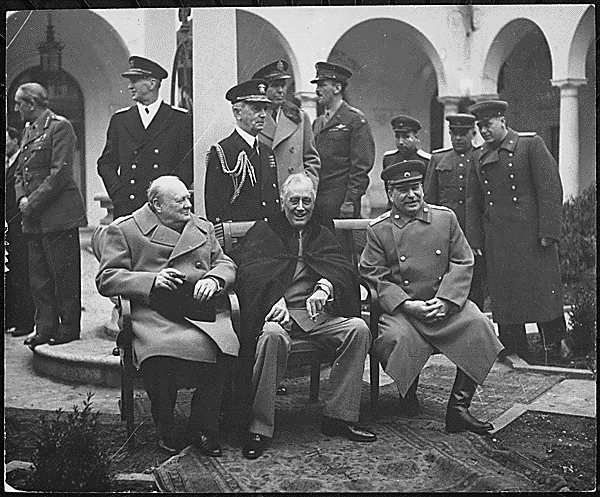Europe in 1945
By the end of WWII Europe was vastly different from how it had been when war broke out six years earlier. Moreover, even though the conflict had finished, new hostilities and tensions between the Allied Powers were already beginning to emerge in 1945.
Tensions had surfaced in 1943, when Stalin wanted the other Allies to form a second front. They claimed this was impossible, and Stalin felt that the other Allies were deliberately leaving Russia to have to defeat the Nazi forces on the Eastern Front. Having to shoulder the fighting in Eastern Europe would, Stalin thought, leave the USSR so weak that it would be vulnerable to the Allies when the war was over.

In February 1945, the ‘Big Three’ - Winston Churchill, Franklin Roosevelt and Joseph Stalin - met at Yalta where the following was agreed upon:
- Following the defeat of the Nazi, those who had been living under their rule across Europe should be given their freedom back, rather than their lands being given to the Allies.
- However, Germany suffered a slightly different date - the Big Three decided that the country would be quartered with each of the Ally powers (Great Britain, France, the US and the USSR) taking one of the four zones.
- In much the same way, the German capital of Berlin would also be split up into four sections and handed over to the Allies.
- With much of the fighting having taken place on its land, it was decided that Russia would take half of the $20 billion war reparations that Germany was ordered to pay.
- The east part of Poland was also given to the USSR, which would in turn help the country create a buffer against the Germans, meanwhile Poland would take land from Eastern Germany so it was not penalised.
- The USSR would provide troops for the fighting that was still taking place in the Far East against the Japanese.
- A new organisations - the United Nations - would be established to help promote and keep world peace.
One of the main issues that needed to be resolved by the Allies was what was to be done with Nazi-occupied nations after the war. What quickly became evident was that Stalin had a very different concept of what a free and democratic government was compared to the rest of the Allies. Namely, Stalin wanted it to be subordinate to the USSR.
Soviet Russia was in a strong position in 1945 - the countries army made its way across eastern Europe and headed for Berlin and by May 1945, when the Nazis waved the white flag, the USSR’s Red Army had control of much of Eastern Europe. While Stalin and the Red Army were hailed as liberators at first, this opinion soon changed as the reality of the Communist rule set in and people’s freedom was limited.
Roosevelt’s death on 12 April 1945 was a turning point in relations between the US and the Soviet Union. Harry Truman succeeded Roosevelt and he took a far less lenient view towards Russia - he also had the extra power granted to him by the fact that by this point American had successfully developed the atomic bomb, the most deadly weapon on the planet.
Following the Nazi surrender, a meeting was held from 17 July to 2 August 1945 between the Allies at Potsdam where they discussed the fate of Germany. However, with the meeting only half complete, the British Prime Minister Winston Churchill was defeated in an election and so was replaced Clement Attlee, thus bringing proceedings to a halt and many issues were left unresolved, including a decision on where a new border between Germany and Poland would be drawen.
Truman told Stalin that America had a ‘powerful new weapon’ at Potsdam, but did not give more information. He soon found just how powerful this weapon was and when the US dropped atomic bombs on Hiroshima and Nagasaki, the USSR quickly realised just how far behind the Americans they were in the arms race.
By the end of 1945, the two superpowers (the USSR and the US) were no longer united by a common enemy. The seeds of the Cold War had been sown.
See also: Europe 1945 - 1950
MLA Citation/Reference
"Europe in 1945". HistoryLearning.com. 2025. Web.
